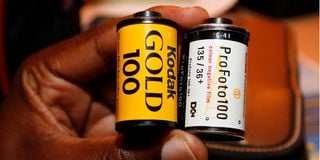Premium
The crucial management lessons in Kodak’s decline

Kodak film cartridges.
What you need to know:
- So big was Kodak that when offered a chance to partner with the Olympics at Los Angeles in 1984, they turned it down.
- The much smaller Fuji quickly snapped up the rights and with it a chance to snatch some market share from Kodak in the US.
An early morning call with a telco staffer this week got me reflecting on the story of Eastman Kodak. Once the most dominant name in photography, they went bankrupt for betting against digital photography.
By the 2000s, digital cameras had become widespread, and available on mobile phones. Meanwhile, feeling big and invincible, Kodak was still pushing hard to sell photo film, banishing executives who tried to pursue digital.
And Kodak was big. A century of innovation had made them the undisputed king of their sector. They introduced the first practical portable camera. Now photography could get out of the studio into our daily lives.
A sleek and clever marketing campaign made photography synonymous with families recording their fun and happy moments. Mothers would make sure to have a camera and of course rolls of the Kodak colour film on hand, to record Kodak moments such as a baby’s first steps or as children shrieked in excitement on a death-defying fun ride at the amusement park.
So big was Kodak that when offered a chance to partner with the Olympics at Los Angeles in 1984, they turned it down. Their competitor, much smaller Fuji, quickly snapped up the rights, using the games as the perfect opportunity to snatch some market share from Kodak in the US. More responsive to market changes, Fuji moved steadily into digital imaging, and more importantly diversified into beauty products.
What do beauty products have in common with photo film? Quite a lot, it turns out! Apart from the fact that we prefer to take photos when we are all made up and looking good, the very chemical compounds used to perfect colour photo film are also used in many beauty products – and Fuji had over 2,000 of them! Go figure.
Failed revival efforts
On a visit, I was awed by the Kodak’s HQ in Rochester, New York. Their annual revenues peaked at US$16 billion in 1996. But after 15 years of failed revival efforts, the company finally went bankrupt in January 2012. In contrast, Fuji thrived, raking in 18.64 billion euros in 2023 revenues.
Back to the telco phone call. The issue at hand was a pay bill number application by a small business. Several forms, dozens of documents, many phone calls and three months later, a sticky issue still remained. One of the shareholders, with a 0.2 per cent stake in the business, is deceased. As is customary, the company registry form number 12 - CR12 for short - reflects this, stating clearly that the stake now belongs to the estate of the deceased. CR12 is the formal document that shows the shareholders of the company, how much they each own, the directors, and the company secretary.
As they reviewed the application, the telco asked for documentation of the “in estate of”. They wanted to know if the in-estate of was a registered entity and if so, could we furnish them with registration documents. Stunned, and after several phone conversations to explain what in-estate was, we offered the death certificate of our deceased shareholder.
The call two weeks later, was to inform that the application had been returned, with the requirement that we fill a form, demonstrating the beneficial owners of our small business. It is a new form, introduced by CBK last month, the staffer offered, sensing my disbelief.
Declaration of beneficial ownership is, of course, not new. If you hold shares in trust as a nominee, you are legally required to declare that to the registrar. This enables identification of the real owners of a company when necessary, such as during a due diligence process. The requirement does not apply to persons holding shares on their own behalf.
Financial inclusion
Safaricom is without doubt, the dominant telco in Kenya and the region. They have done extremely well for their shareholders and the Republic, driving mobile penetration to 118.7 per cent. Their payments channel is everywhere, making them an obvious choice for any business looking for a payment channel for its customers.
Mobile money has brought financial inclusion up to 84 per cent, but much to the surprise of experts welfare measures have deteriorated in recent times. At the heart of the telco’s growth was simplicity and convenience for the customer. They made it possible to move money and make payments with a few easy steps.
Could their size and dominance be making them complacent as it did Eastman Kodak before them? If it takes more than three months, many hours of staff time, lots of back and forth, to on-board one small business client, how long will it be before competitors catch up? What will happen when Starlink offers mobile money?
Perhaps a rich telco can afford the cost of all that staff time and the back and forth. Most small business cannot. For the particular small business, it was all too much. They declined to fill any more forms, offering the forget the application altogether.
Kenyan banks once viewed accounts as a privilege. To have one, you had to be introduced and maintain a minimum cash balance.
That disdain for customers opened the way for a new breed of Kenyan owned banks to speed past the old. And with the Kibaki I government running a balanced budget and not borrowing, traditional banks suddenly found themselves in need of borrowing customers, forcing them to put up tents on the sidewalks of Nairobi as they hawked salary loans. The never recovered, as the complacent cannot compete.
In its current path, will our favorite telco go the way of Eastman Kodak or Fuji Corporation?
@NdirituMuriithi, an economist, is partner at Ecocapp Capital





